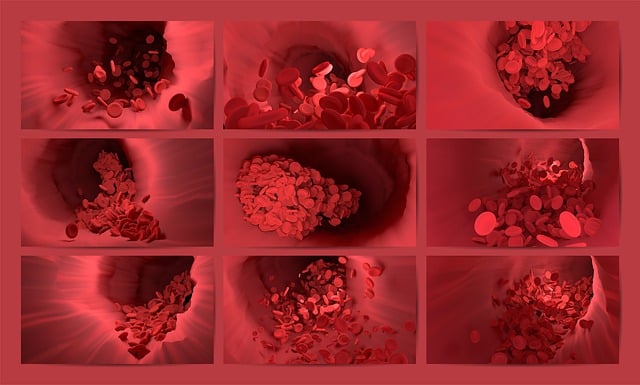


The main causes of death in Brazil and other Latin American countries are ischemic events such as heart attacks and strokes (image: Narupon Promvichai/Pixabay)
Published on 11/04/2024
Agência FAPESP* – A study conducted at the Center for Research on Redox Processes in Biomedicine (Redoxoma) helps understand how high blood sugar (hyperglycemia), one of the manifestations of diabetes, can cause thrombosis. The findings, reported in an article published in the Journal of Thrombosis and Haemostasis, can contribute to the development of strategies to prevent cardiovascular dysfunction in diabetics.
“The leading causes of death in Brazil and several other Latin American countries are ischemic events such as heart attacks and strokes, in which arterial thrombosis is a major precipitating factor. These cardiovascular disorders can arise out of several risk factors, such as hyperglycemia, dyslipidemia and hypertension. Among these, hyperglycemia appears to be associated to a significant extent with cardiovascular disease,” said Renato Simões Gaspar, first author of the article.
The investigation was conducted with support from FAPESP during Gaspar’s postdoctoral research and led by Francisco Laurindo, last author of the article. Laurindo is a professor affiliated with the University of São Paulo’s Medical School (FM-USP) in Brazil and a member of Redoxoma, which is a Research, Innovation and Dissemination Center (RIDC) established by FAPESP at the Institute of Chemistry (IQ-USP). Gaspar currently teaches at the State University of Campinas (UNICAMP).
According to the authors, prolonged hyperglycemia and diabetic ketoacidosis are associated with a heightened risk of thrombosis because they cause endothelial dysfunction (alterations to the inner lining of blood vessels), whereby binding of platelets to endothelial cells triggers thrombus formation.
The study showed that peri/epicellular protein disulfide isomerase A1 (pecPDI) regulates platelet-endothelium interaction in hyperglycemia through adhesion-related proteins and alterations in endothelial membrane biophysics.
“We found that a pathway for this PDI in endothelial cells mediates thrombosis in diabetes when hyperglycemia is present, involving a specific molecular mechanism, which we identified,” Laurindo said.
PDI is an enzyme that resides in the endoplasmic reticulum and has the classic function of catalyzing the insertion of disulfide bridges into nascent proteins so that they coalesce in the correct shape, i.e. so that the amino acid chain folds to form the three-dimensional structure that makes the molecule functional. It is also found in the extracellular space as pecPDI, a pool secreted or bound to the cell surface, in various types of cell including platelets and endothelial cells. Studies have shown that pecPDI regulates thrombosis in several models.
Biochemical and biophysical modifications
To investigate platelet-endothelium interaction in hyperglycemia, the researchers created a model with human umbilical vein endothelial cells cultured in different glucose concentrations to produce normoglycemic and hyperglycemic cells and assessed PDI’s contribution using whole-cell PDI or pecPDI inhibitors.
The cells were incubated with platelets derived from healthy donors. The platelets adhered almost three times more in hyperglycemic than normoglycemic cells. PDI inhibition reversed this effect, and the researchers concluded that the process is regulated by endothelial pecPDI.
To obtain a better understanding of the result, they investigated biophysical processes such as endothelial cell cytoskeleton remodeling and found that hyperglycemic cells had more well-structured actin filament fibers than normoglycemic cells. They also measured production of hydrogen peroxide, an oxidizing compound, because reactive oxygen species are mediators of cytoskeleton reorganization and cell adhesion. Hyperglycemic cells produced twice as much hydrogen peroxide as normoglycemic cells.
The researchers then investigated whether cytoskeleton reorganization affected cell membrane stiffness, since substrate stiffness increases platelet adhesion. Using atomic force microscopy, they demonstrated that hyperglycemic cells were stiffer than normoglycemic cells.
The microscope images also showed the formation of cell elongations with extracellular vesicles that appeared to separate from the elongations. This observation led the researchers to investigate the secretome – the set of proteins secreted by an organism into the extracellular space – in order to find out whether it included proteins that enhanced platelet adhesion. “The purpose of this experiment was to detect proteins exclusively expressed by or present in hyperglycemic cells and not in controls or cells treated with PDI inhibitors,” Gaspar explained.
In the secretome, they found 947 proteins, from which they selected eight with a role in cellular adhesion. They then silenced gene expression for three of these proteins using RNA interference and arrived at two proteins, SLC3A2 and LAMC1, as modulators of platelet adhesion. SLC3A2 is a membrane protein, and LAMC1 is the gamma subunit of laminin 1, a key component of the extracellular matrix.
The conclusion was that exposure to hyperglycemia induced secretion of specific adhesion-linked proteins and that PDI and pecPDI inhibition prevented endothelial cells from secreting these proteins.
The article “Endothelial protein disulfide isomerase A1 enhances membrane stiffness and platelet-endothelium interaction in hyperglycemia via SLC3A2 and LAMC1” is at: pubmed.ncbi.nlm.nih.gov/39128656/.
* With information from Redoxoma.
Source: https://agencia.fapesp.br/53215